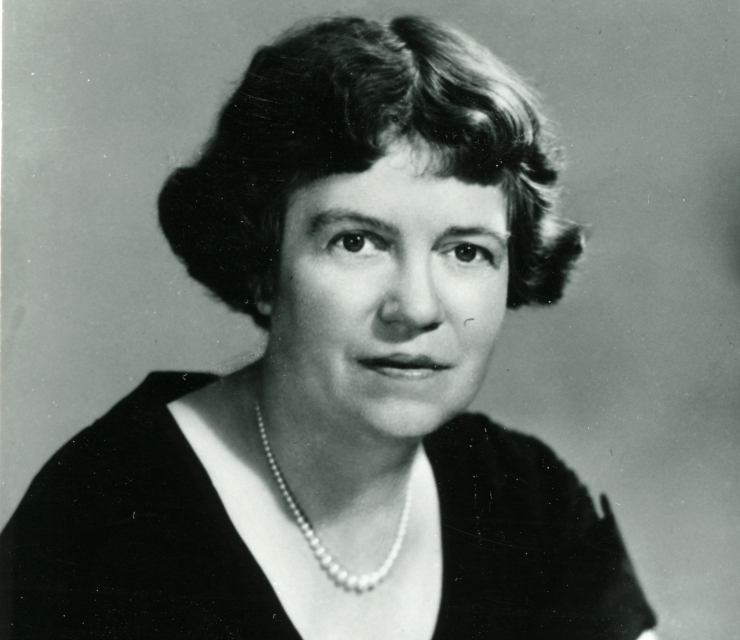Pioneering Anthropologist Advances the Academy
Anthropologist Margaret Mead brought attention to cultural perspectives on scientific change.

Published May 1, 2017
“The Academy has stood for new ideas, for the adventurous and experimental,” said Margaret Mead, at a celebration of the Academy’s 150th anniversary in 1967.
“Adventurous and experimental” well describes Mead’s own career. As a new PhD in the 1920s, she carried out pathbreaking—and controversial—anthropological fieldwork on childhood and adolescence among indigenous South Pacific peoples. She later turned her attention to the context of youth in her own society, famously commenting on the “generation gap” of the late 1960s.
An outspoken public intellectual, Mead became, during her lifetime, America’s most famous anthropologist. And she used her decades-long association with the Academy to bring attention to cultural perspectives on scientific change in an era that spanned the development of nuclear weapons to the energy crisis of the 1970s.
Getting Involved with the Academy
Mead first became involved in the Academy in the 1930s. By then she had already made her mark with her best-selling books Coming of Age in Samoa and Growing Up in New Guinea.
Her professional home was in New York City, at the American Museum of Natural History (AMNH), where she became Curator of Ethnology—and where the Academy’s headquarters occupied two rooms during the 1930s and 1940s.
It’s possible that Eunice Thomas Miner, the Academy’s Executive Director at the time, recruited Mead—Miner initiated an unprecedented Membership drive in the late 1930s. Both women held the title of Research Assistant at AMNH, where they became friends as well as colleagues.
For the next 40 years, Mead’s perspective as an anthropologist shaped Academy affairs. She understood science as a product of culture. In Academy forums and elsewhere, she compared science in different national contexts, professional and public understanding of science, and perception of science by young people and older generations.
Her many articles and talks on the implications of these different perspectives—whether for nuclear war, space exploration, science education, scientific literacy of the public, and other issues—converged with a growing concern within the Academy about the place of science in society.
Contributions to the Academy
Throughout this time, Mead contributed research to Annals, organized meetings, and served the Academy in official capacities, at different times as Chair of the Anthropology section, Vice President of the Scientific Council, and Vice President of the Academy.
The Academy first provided a platform for Mead’s research in 1942, when it published her book with Gregory Bateson, Balinese Character: A Photographic Analysis. Carried out from 1936 to 1938, Bateson and Mead’s fieldwork in Bali made unprecedented use of photography and film, generating some 25,000 still images.
Earlier anthropologists had taken photographs, but this project was the first to do so on such a large scale, and also the first to present the visual record as the primary scientific evidence with written documentation secondary. The book helped launch the new field of visual anthropology and it remains a classic today.
As she became more involved with the Academy, Mead valued its ability to convene experts in “symposia on the growing edge of knowledge,” as she put it—and “the structure it provided for creative interchange among the sciences.”
Considering the Cultural Implications
In October of 1957, one of these frontiers was launching earth-orbiting satellites. Mead later recalled that the announcement of the Soviet Sputnik launch came only two hours after she had mailed invitations to an Academy conference on the cultural implications of “man in space.” The conference was held later the same month, and the proceedings were published in Annals the next year.
By the 1970s, when the cultural relevance of science came more and more into public view, Mead returned to theme that she often explored—the distance between specialists and non-specialists; between scientists and the public. To her thinking, improving science education at all levels was vital to bridging this gap and ensuring both scientific advances and informed public debate and decision-making.
These and many other issues that Mead tackled in the 1960s and 1970s remain relevant to the Academy today, including childhood nutrition and the challenges faced by women in science. She was, “Always helpful to this Academy,” in the words of a 1973 citation praising her as an Academy Governor, and could “be counted on for sound advice based on high principles.”
Learn more about Mead
- Clifford Geertz’s 1989 biography, Margaret Mead, 1901-1978: A Biographical Memoir, published by the United States National Academy of Sciences.
- Jane Howard’s 1989 biography, Margaret Mead: A Life.
- The History of The New York Academy of Sciences.
Also see:
